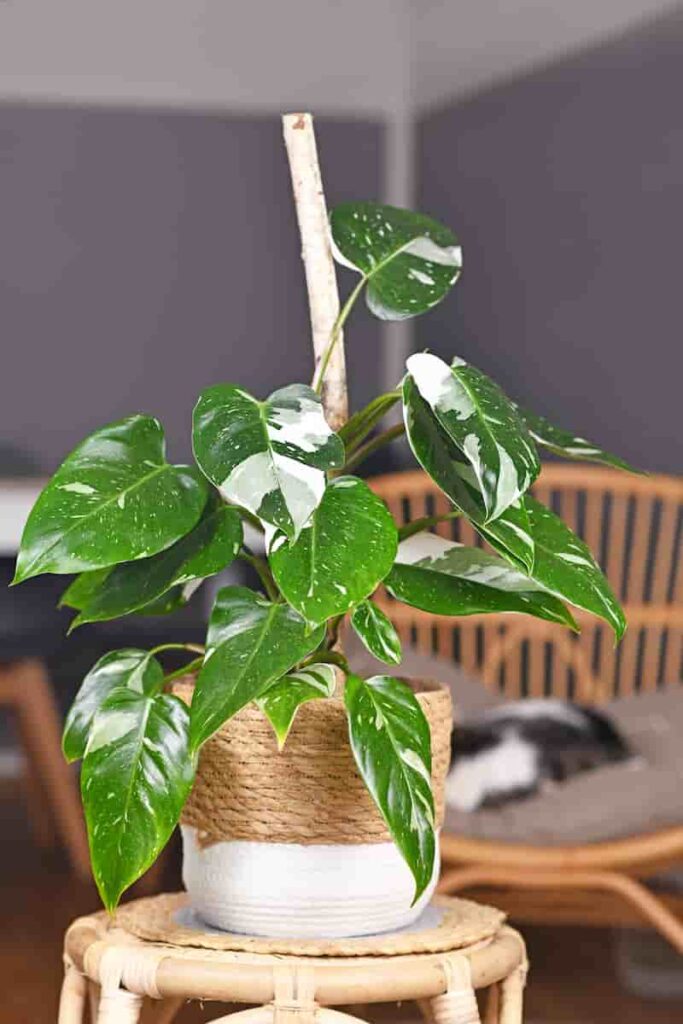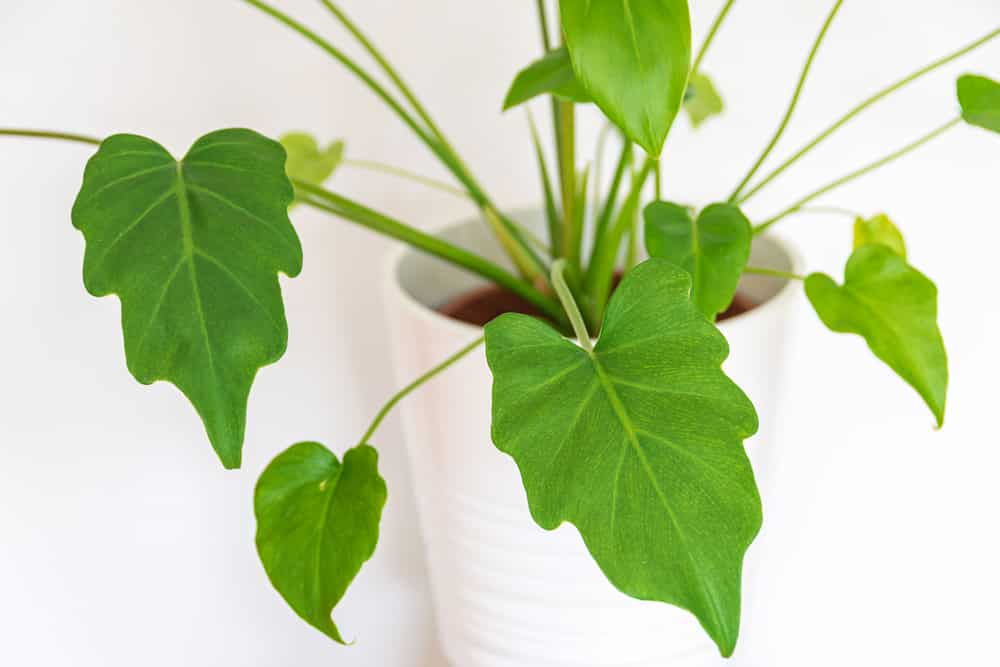Nothing brightens up a living space quite like healthy, thriving houseplants. And philodendrons are a particularly good choice, given their low maintenance care requirements and striking good looks. These tropical evergreens are known and loved for their vining growth patterns and glossy heart-shaped leaves.
That said, philodendrons do tend to enter a bit of a leggy, awkward teenage phase if they’re left to their own devices for too long or if their needs are not fully met. The consequence is a plant that looks a bit sparse or thin in places instead of bushy and clustered, as is its norm in the wild.
To prevent this and make a philodendron fuller, there are a few steps you can take (with aftercare requirements) that will keep your plants looking their bushy best. In this article, we’ll outline everything you need to know about pruning your philodendrons, preventing legginess, as well as how to encourage branching.
Ready? Let’s get to it!

Table of Contents
How to make a philodendron fuller
The best way to make a philodendron bushy is to ensure it is pruned carefully and regularly, fertilized seasonally, and provided with sufficient light. Pruning, specifically, can better direct your plant toward a clustered growth habit rather than a strictly vining one, which often results in a balding top.
As any houseplant enthusiast can attest, how you care for your plants directly impacts their growing aesthetic. Personally, I go by my rule of five, which entails keeping an eye on light, water, soil, humidity, and feeding. Experience has taught me that if any of these needs are in a deficit, I’ll end up with a sparse, leggy philodendron with fewer leaves and scraggly vines.
But that’s not the end of the world. Being mindful in your care regime can help to prevent the leggy phase quite easily and doesn’t require a ton of effort. Indeed, it’s more a case of being conscientious about pruning and understanding the biology of your plant to ensure its best chance of thriving.

In the following sections, I’ll take you through my best practices for making my philodendrons fuller, from preparing your pruning tools to how and when to feed your plants.
1. Prepare for pruning
In just a moment, we’ll go into detail about pruning philodendrons and why it’s so crucial for ensuring voluminous growth. But first, let’s talk about hygiene.
When using tools interchangeably between plants, there’s always a risk of transferring bacteria or fungi, making it a risky business for all your green babies. And this is the last thing you want when you’re trying to encourage new growth.
Pro tip: To prevent this, it’s essential that you sterilize and clean your pruning tools between every gardening session. I use rubbing alcohol, followed by a good rinse in hot water.
However, you can also use a diluted solution of one part bleach to nine parts water, provided you wash off your tools with boiling water after the fact.
Once all your instruments are clean, you can get down to business.
2. Encourage bushier growth through pruning
Pruning is valuable for philodendrons because it encourages new growth. Indeed, the natural course for any plant is that, over time, existing leaves and stems get old and start to decay. When this happens, plants waste energy on older foliage that could be better spent on new buds and leaves.
So, when it comes to making a philodendron fuller, regular pruning of dying leaves and leggy stems redirects the plant’s energy to produce new vines from root nodes. For a bushy look, snipping or pinching your longest vines will encourage more production from the plant’s center.
On that note, always ensure you prune just above healthy nodes, lest you end up with unsightly stem ends that will yellow and wither. Gently laying nodes against the soil in your planter is also highly effective for denser center growth – but more on this shortly.
You may also be interested in: What is a Philodendron’s Growth Rate (+ How To Grow It Faster)?
3. Prune your philodendrons during their growing season
Usually, pruning should be reserved for your plants’ growing seasons, in the spring and summer. However, philodendrons can be pruned year-round, as long as you don’t go too crazy on them! In fact, your pruning should be so marginal that it’s barely noticeable. Think of it more as regular maintenance.
In other words, should you notice a yellow leaf on your philodendron or spindly stem, it’s okay to snip it, even in the depths of winter. Just don’t go wild and cut off huge chunks of your philodendron that may result in shock and, by default, slowed or unsteady growth.

4. Meet their light requirements for denser growth
At the heart of it, philodendrons are tropical plants that enjoy bright, indirect light and plenty of humidity. If they aren’t receiving these two things in their relative quantities, it follows that their growth will be on the scraggly side.
And if you’re wondering what the connection between leggy growth and sunlight is, the answer is both sweet and straightforward. Vines and stems get long and thin when your plants are reaching for the sun, trying to absorb as much of it as possible (we have to hand it to plants – they’re great communicators).
Therefore, from the get-go, it’s beneficial to meet your philodendron’s light requirements by giving it at least 7 to 8 hours of sunlight daily by positioning them in an area close to a window. In the winter, when it’s cooler, you can supplement this intake with a few outdoor hours in a sunny spot on your balcony or patio. Or, if you’re really not winning, invest in a grow light.
5. Provide sufficient fertilization to encourage fuller growth
In their natural environments, philodendrons grow in the shade of larger plants enjoying all the nutrients provided by the jungle floor’s soil. This encompasses decades of an intricate ecosystem designed to keep wild plants thriving, which, unfortunately, can never entirely be mirrored by regular store-bought potting soil.
But this is why we have fertilizer.
Occasional feeding with a slow-release fertilizer can encourage new, fuller growth in your philodendrons by providing them with a kick of supplemental nutrients. This is excellent news if your plant is leggy despite your best efforts with pruning and lighting, as it may indicate a deficit of minerals in your soil.
Related: Fertilizing Your Philodendron: The Ultimate Guide
6. Adequately hydrate and provide general care
Even the hardiest of plants (and philodendrons are up there!) don’t do well with inconsistent care, which becomes evident in how they grow. While these beauties are pretty drought-tolerant, leaving them without water for long periods will not be great for bushy growth and tends to result in lots of dead or dried-out leaves.
As a general rule of thumb, try to water your philodendrons as soon as their top inch of soil is dry. And don’t fall into the trap of thinking that overwatering will help them, either.
Conversely, this suffocates their roots and prevents them from growing altogether, also often resulting in deadly infections like root rot in your philodendron.
How do you fix a leggy philodendron?
To fix a leggy philodendron, start by revisiting your care practices to ensure your plant receives enough light and nutrients while simultaneously encouraging fresh growth through pruning. You can also fill in a sparse or balding plant with propagated stem cuttings to boost fuller growth from its center.
In the previous section, we looked at encouraging density in a philodendron. But what do you do if your green-leafed beauty is already leggy? How much of its growth habit can be undone? No need to fret – there’s a lot you can do, and you should see results in under two months.
Pruning is the most obvious route, redirecting your plant from growing lengthy stems by reigning them in toward your center. I usually opt to cut my stems close to the base of the plant, allowing nodes to lay just on top of the soil, where they are inclined to root and branch.

Another fix I’ve found that works wonders is recycling the fruits of my vine pruning into stem cuttings, letting me propagate my philodendron through water rooting.
These cuttings are usually short (2 inches / 5 centimeters), with one or two nodes and one or two leaves. I pop them into a small container with water for 3 to 4 weeks until they have their own little root systems.
And once I have a few of these, all that’s left to do is plant them into the sparse areas around the center of my philodendron’s base. In no time, they should start to fill in the gaps, making your plant look fuller than ever before.
How do you make a philodendron branch?
Branching your philodendrons will encourage them to grow multiple vines, resulting in a fuller aesthetic. You can achieve this through stem pinching, which is the practice of nipping off the end of vines with new leaves, thereby bolstering your plant to shoot out lateral stems in their place.
If your philodendron is growing long, singular vines, you may want to consider trying to branch it out for a fuller growth habit. These plants are remarkable in how they respond to pruning and pinching, particularly when they’re at their healthiest.
Stem pinching is a straightforward process that won’t take you more than a minute. It’s quite literally the practice of pinching off a spot with new growth (typically the end of a vine with new leaves) so that your plant energetically tries to replace it.
That said, you need to leave visible stem nodes in place, from where new growth can develop. Two or three is preferable, as this is ideal for lateral branching. And the closer you can get them to your soil, the better, as this will mean extra nutrients and moisture for forthcoming roots.
